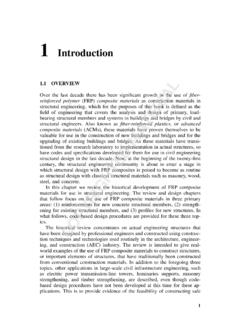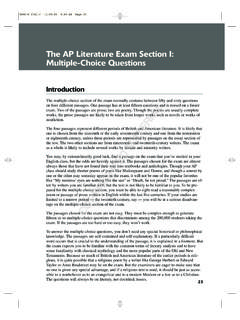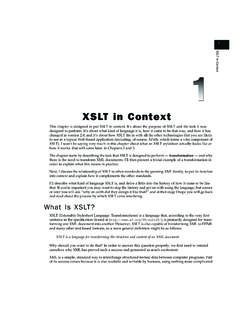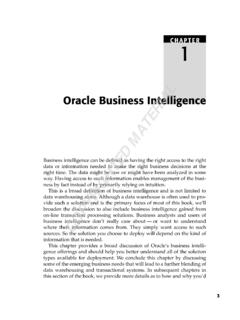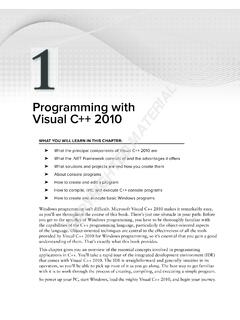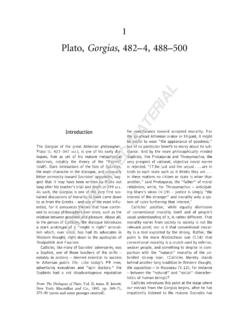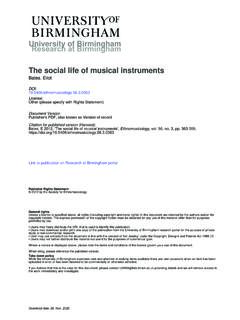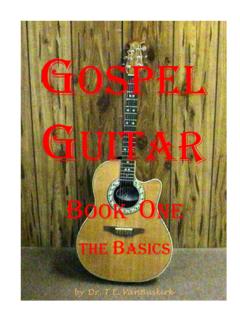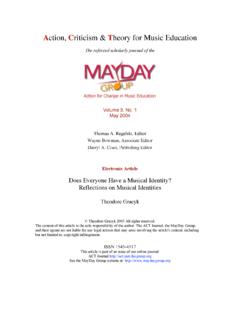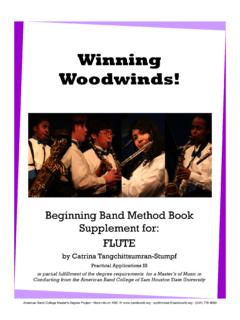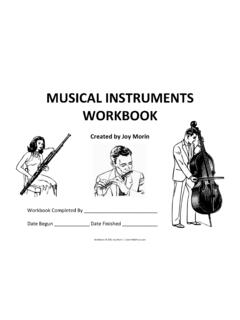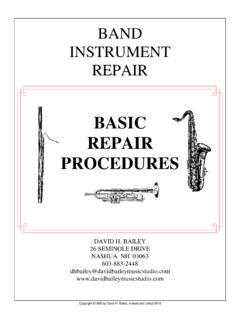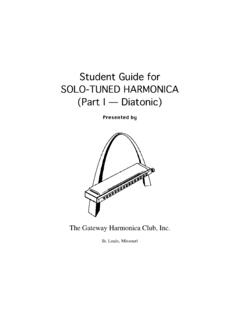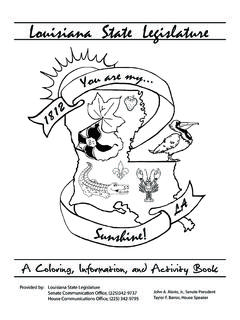Transcription of Chapter 1 First Steps: Banjo Basics - John Wiley & Sons
1 Chapter 1 First Steps: Banjo BasicsIn This Chapter Getting to know different kinds of banjos Exploring the Banjo and all its parts Discovering how to be a good playerIf you take a trip, you d probably like to know where you re going (after all,you don t want to end up like those guys in that Deliverancemovie, doyou?). If you re new to the Banjo and don t yet own an instrument or if you rewondering about your eventual musical destination, this Chapter is definitelythe place to start your Banjo For Dummiestrip. The key is in the ignition, soput this thing in drive!In this Chapter , you spread out your Banjo road map and start planning what I hope will be a wonderful, lifelong musical journey with the five-string discuss what makes the five-string Banjo different from other kinds ofstringed instruments , and you can also take a look at the various kinds ofbanjos available today.
2 I name the parts of the Banjo and summarize themusical skills you can master in this book on the way to becoming a into BanjoSomething about the five-string Banjo brings out strong feelings in who like the Banjo usually reallylike it. What is it about this instrumentthat inspires such passion, and how can you tell if you ve been bitten by thebanjo bug? This section explores the answer to these 7/5/07 11:17 PM Page 11 COPYRIGHTED MATERIALL oving that amazing soundYou know the sound of the Banjo when you hear it: the bright, rhythmicwaterfall of short, cascading notes that can conjure up just about any emo-tion (but usually happyfirst comes to mind for the typical guy on the street).
3 The Banjo is usually associated with folk, country, and bluegrass music, butthese days, you can also hear the instrument in jazz, rock, and even the years, I ve asked hundreds of amateur and professional players whythey initially got interested in the instrument and the usual answer is I fell inlove with the sound. I think an equal attraction is the lure of hearing a lot ofnotes compressed into what seems like the smallest of musical spaces. In thehands of a skilled player, the Banjo is an instrument that s capable of a true believerBanjo players usually remember well the precise moment in time that theybecame hooked on the instrument.
4 For me, growing up as a suburbanteenager far from significant hills of any kind, that moment was when I waswatching Roy Clark play Banjo on Hee Hawand thinking to myself, If I cansomehow sit through this show every week, I think I can eventually learn Cripple Creek. I didn t especially like country music at that time, and I dnever heard of folk or bluegrass music but I really loved the sound of up in the 1970s, I could also hear the Banjo as a background instru-ment on hit songs from the Eagles, the Doobie Brothers, Neil Young, andJames Taylor. Hearing the Banjo in these contexts made me believe that thebanjo mustbe cool if those musicians used it on their recordings, despitewhat my friends thought about this disturbing turn in my musical , of course, I was also influenced by the popularity of Dueling Banjos during these years (I didn t realize until years later whowas depicted playingthe instrument in this movie).
5 I already knew a little about playing the guitar,and I decided that I wanted to try and teach myself to play enrolling in a community college beginners Banjo class, I discovered anentire musical subculture of folk and bluegrass music where the Banjo wasnot only welcome, but was also pretty much the most revered instrument ofthem all. Getting to know others who felt the same way as I did about thebanjo really helped to get me I: The Amazing Five-String Banjo 05_127629 7/5/07 11:17 PM Page 12 Almost 40 years later, I m happy to report that the Banjo is more popular thanever. Musicians have continued to push the musical boundaries of the instru-ment, and these days, about the only folks who think the Banjo is good forjust one musical style are those television producers who still insist onhaving Banjo music in the background of their pickup truck own youthful enthusiasm for the Banjo evolved into a wonderful lifelongrelationship that is still growing strong.
6 I get a joyful feeling every time I playa tune on the Banjo . I m also amazed at how my love for the instrument hasopened the door to many new and wonderful experiences (such as graduateschool, international touring and teaching, and this book !) and is at the basisof many of my most cherished friendships. Even if you never become asobsessed about the Banjo as I am, I believe that the Banjo can improve yourlife and make you a happier person if you give it the Different Kinds of BanjosBanjo For Dummies is your complete guide to musical adventure on the five-string Banjo . I focus on the five-string Banjo because this instrument is by farthe most popular type of Banjo being played today and is the kind of banjothat is used to play bluegrass, folk, and country music.
7 The five-string banjois also currently carving new niches in jazz, rock, and classical , in the First half of the 20th century, the most popular banjos werefour-string tenor and plectrum banjos. These banjos are really differentinstruments and shouldn t be confused with the five-string Banjo . Under-standing the differences between banjos is important, because before youbegin your adventure, you need to make sure you re traveling with the rightkind of the following sections, I compare and contrast the different instruments inthe Banjo family, so you don t mistake one type of Banjo for Banjo : The subject of the bookThe short 5th string is what makes the five-string Banjo different from othertypes of banjos and from just about every other instrument in the known uni-verse.
8 Most of the time, you know immediately that you re looking at a five-string Banjo when you see a tuning peg(a geared mechanism that keeps thestring in tune) that s sticking out almost halfway up the neck(the long narrowpiece of wood where you fret strings with the left hand; for more on these13 Chapter 1: First Steps: Banjo Basics05_127629 7/5/07 11:17 PM Page 13terms, see a later section on the parts of the Banjo ). This tuning peg holdsthe 5th string of the Banjo (see Figure 1-1).The 5th string is a crucial distinguishing characteristic of the five-stringbanjo, both in the instrument s appearance and the sound of the music.
9 The5th string is not only shorter than the other four strings of the Banjo , but thisstring is also the highest in sound (or pitch). The 5th string on a Banjo lieswithin easy reach of the right-hand thumb, which you use to play this stringin all kinds of Banjo music. Having the highest-pitched string next to thestring with the lowest pitch is unusual in comparison to how pitches arearranged on the strings of a guitar (as you can see in Figure 1-1), but this isone of the things that makes the Banjo sound so great! This characteristic ofthe Banjo is also one part of the instrument s ancient African ancestry (formore on this, see Chapter 7).
10 Tenor and plectrum banjos: Look for another bookIn the early decades of the 20th century, folks loved the quality of sound ofthe Banjo so much that they attached different kinds of necks to the banjobody to create new instruments with different numbers of strings. Thesehybrid instruments were tuned and played differently from the : Pitch: LowHigh64563213452154321 Five-string banjoStrings: Pitch: LowestHighestHigh45321 Figure 1-1:Comparingstrings andpitches on aguitar (left)versus afive-stringbanjo (right).14 Part I: The Amazing Five-String Banjo 05_127629 7/5/07 11:17 PM Page 14 Tenorand plectrumbanjos are examples of this phenomenon.
